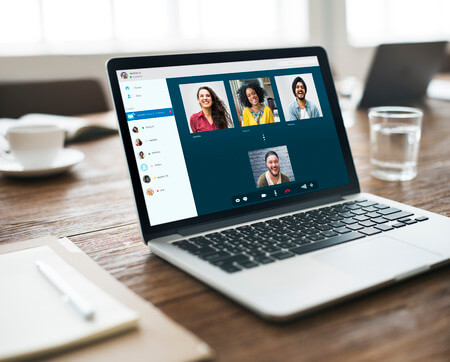The Importance of Mentoring in a Remote Working World
Most people now recognized that remote working has become mainstream. Now we can easily collaborate with IM and email, communicate with video conference calls and group edit presentations without second thought. Other factors, however, still need to catch up, including the role of mentoring in a remote working world.
Those of us with a few decades of experience have the benefit of perspective. We grew up in a different world where the social part of work was an embedded component, integrated as part of our normal routine. Group lunches were a common way to seek feedback on business opportunities or policy changes. Nothing like two-martinis to help the discussion.
Today the working world has changed. This means social expectations must also shift, to then become more comfortable with how our working experience has changed.
The cultural and physiological factors that comprise what it feels like to work will likely take much longer to become accepted and recognized as the status quo. This should come as no surprise, as has been the case in other areas of our life where a digital transformation has changed the status quo.
A Brave New World for Millennials Now in the Workforce
The concept of a virtual organization is not revolutionary anymore. I met with a team just a month ago that all work from home. This virtual organization doesn’t have a corporate headquarters. The staff are left to decide where they want to work, based on where they feel they can be the most effective.
The sheer number of remote workers has steadily increased over the past couple of years. The proportion of Americans who did some or all of their work from home is now at 43%, up from 39% in 2012, as reported by a recent Gallup poll. Over the same period, the proportion who only work remotely went to 20% from 15%.
Those now starting their professional careers are entering at an interesting time. I see this first hand through my daughter, who just graduated from college 18 months ago. She now works for a virtual organization. The company is relatively small, with 18 full time staff, but the level of collaboration they can achieved is remarkable, as is the quality of their work. They meet twice a week in a shared executive space, which includes a group meeting from 10 to 3 through lunch. The staff can then work anywhere for the other three days of the week.
Those who work at these types of organizations are happy to have the flexibility that this work environment has to offer. Young families can now better manage parenting duties – as can those with aging parents, where schedule flexibility is a highly appreciated benefit. And, let’s not forget about all the time saved by not sitting in a long commute, especially if that journey lasts an hour or more in each direction.
Reinventing Social in a Work Setting
One item, however, that has the potential to be negatively impacted is the social part of working, when in a virtual office environment. There is something to be said about physical contact and interaction with your co-workers. Being able to share exciting news is far better when done in person. The same can be said of when support is needed when faced with a family situation, or dealing with a loss.
I think Shakespeare had it right: too much of a good thing or excess may do you harm.
Perhaps the perfect work environment is one that has a balance of both. Some days are best spent working remote, finding yourself in a zone to be productive, creative or whatever else you need to do to overcome your current list of tasks and objectives. Other days, however, might be best spent interacting with others, either in the office, over coffee for a meeting, or coming into the office, if that option exists.
This difference may be even more pronounced for those who are in the early phases of their careers, still finding their path and learning the language and characteristics of their respective industry. More seasoned workers have achieved more of a stability such that remote working might be better suited, or less of a challenge.
As a suggestion to those organizations that are 100% virtual, it might make sense to have regularly scheduled time for group interactions, perhaps once a month or every other month. If your team is geographically dispersed, then these meetings will need to be split up to offer each local employee an opportunity to be the host, welcoming his or her co-workers to their hometown. Over time, this activity will create a sense of closeness and trust, key qualities that are necessary in order to go from “good” to “great,” in the words of Thomas Friedman.

Mentoring in a Remote Working World
One of the concepts that is a bit more difficult to achieve is the role of a mentor, and how constructive feedback can be shared without it being too “canned” or impersonal. Quite often these types of lessons are best learned on-the-fly as they occur. It is often very difficult to recreate situations weeks later, with the goal of self-reflection on how a situation might have been managed differently or handled better.
A mentor can come in many forms, not necessarily an employee’s immediate superior. This education typically came from proximity to having an office down the hall from a seasoned veteran that always has their door open. Alternatively, it could build from sharing a common interest, or even getting in the habit of having lunch together on a regular basis.
In the absence of physical proximity to strike conversations on life lessons, the more senior employees need to take greater care to look for signs that co-workers need help, or if they could use a sounding board on a difficult decision. In these cases, a virtual clue needs to be shared that the “door is always open”. This could come in the form of an IM program, such as Slack or Microsoft’s Skype for Business.
One of the things I like about Skype (and other IM applications) is the color-coded status button, indicating if you are in a meeting, away from your desk, or currently available. A green persistent light is the equivalent of an open door – provided you are quick to respond to an IM with a question. A timely response is critical. Often opportunities for learning are fleeting, depending upon what the unique set of circumstances are that led to the issue that needs discussing.
Managers can also use applications such as Prodoscore to see when employees might be experiencing issues and intervene to help them or see what’s going on.
Conclusion
Younger workers entering the workforce today do so without previous knowledge or experience of what they don’t have, as well as how good they have it. With no comparative baseline, their experience today will become what all future jobs are compared to. Those of us with more experience under our belts have an obligation to help navigate our younger peers through these potentially tricky waters such that a sense of understanding can be learned, including the role of a mentor.
Despite all the advances in Machine Learning and Artificial Intelligence, nothing can take the place of a “real” human touch (at least not yet!). Having someone to speak with in person, to be there at the right time to help provide guidance and experience, is still a basic human need that we all still need.

